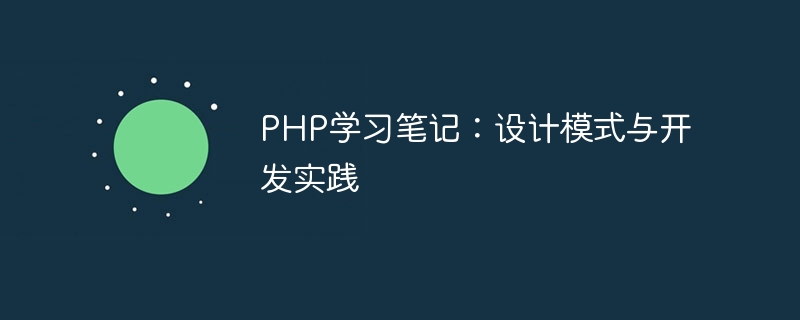

PHP study notes: Design patterns and development practices
In modern software development, design patterns are a very important concept. Design patterns are solutions to common problems in software development, and they are widely used to solve various problems in different fields. In PHP development, mastering design patterns can help us write maintainable, extensible, and reusable code.
This article will introduce several common design patterns and show how to apply them in actual development. We will provide specific code examples so that readers can better understand and apply these design patterns.
1. Singleton pattern
The singleton pattern is one of the most commonly used design patterns. It ensures that a class has only one instance and provides a global access entrance. In PHP, you can use the following code to implement a singleton pattern:
class Singleton {
private static $instance;
private function __construct() {}
public static function getInstance() {
if (self::$instance == null) {
self::$instance = new self();
}
return self::$instance;
}
}
$singleton = Singleton::getInstance(); In the above code, the private constructor ensures that the class cannot be instantiated directly through the new keyword. getInstance method is used to obtain a singleton instance. If the instance does not exist, create a new instance; if the instance already exists, return the instance directly.
2. Factory pattern
Factory pattern is a pattern used to create objects. It achieves object decoupling by moving the object's instantiation code into a separate factory class. In PHP, you can use the following code to implement a factory pattern:
interface Product {
public function getName();
}
class ProductA implements Product {
public function getName() {
return "Product A";
}
}
class ProductB implements Product {
public function getName() {
return "Product B";
}
}
class ProductFactory {
public static function createProduct($type) {
switch ($type) {
case 'A':
return new ProductA();
case 'B':
return new ProductB();
}
}
}
$productA = ProductFactory::createProduct('A');
echo $productA->getName(); // 输出 "Product A"In the above code, we define a product interface Product and implement two specific product classes ProductA and ProductB. The ProductFactory class serves as a factory class and is responsible for creating different types of products.
3. Observer Pattern
The Observer pattern is a publish-subscribe pattern that is used to decouple the observer and the observed. In PHP, you can use the following code to implement an observer pattern:
interface Observer {
public function update($message);
}
class ConcreteObserver implements Observer {
public function update($message) {
echo "Received message: " . $message;
}
}
interface Observable {
public function addObserver(Observer $observer);
public function removeObserver(Observer $observer);
public function notifyObservers($message);
}
class ConcreteObservable implements Observable {
private $observers = [];
public function addObserver(Observer $observer) {
$this->observers[] = $observer;
}
public function removeObserver(Observer $observer) {
$key = array_search($observer, $this->observers);
if ($key !== false) {
unset($this->observers[$key]);
}
}
public function notifyObservers($message) {
foreach ($this->observers as $observer) {
$observer->update($message);
}
}
}
$observable = new ConcreteObservable();
$observer = new ConcreteObserver();
$observable->addObserver($observer);
$observable->notifyObservers("Hello, observer pattern!"); In the above code, we define the observer interface Observer and the observable object interface Observable. The ConcreteObserver class implements the observer interface, and the ConcreteObservable class implements the observable object interface.
Add observers to the observable object by calling the addObserver method, and send messages to the observer through the notifyObservers method.
Summary:
This article introduces several common design patterns such as singleton pattern, factory pattern and observer pattern, and provides specific PHP code examples. Mastering these design patterns can help us better deal with various software development problems and write high-quality, maintainable code.
Of course, design pattern is just a tool and method, it is not a master key to solve all problems. In actual development, we should choose the appropriate design pattern according to the specific situation and apply it flexibly based on actual needs.
The above is the detailed content of PHP study notes: design patterns and development practices. For more information, please follow other related articles on the PHP Chinese website!